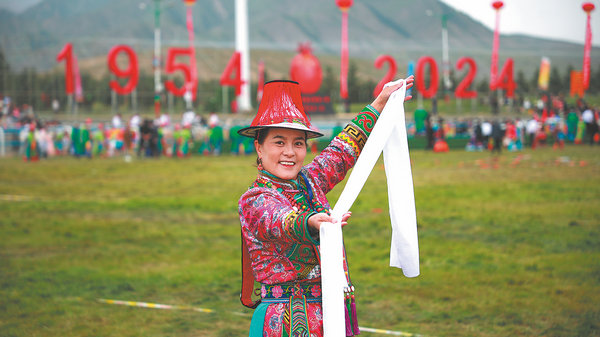

LANZHOU — During recent festivities to celebrate the 70th anniversary of Sunan Yugur autonomous county in Gansu province, the nomadic Yugur people's unique ethnic attire was an attraction in its own right.
With a population of more than 10,000, the Yugur primarily reside at the foot of the Qilian Mountains. For generations, they have maintained their ancient customs, including traditional clothing. Beyond its time-honored functionality, the ethnic group's traditional attire represents a tangible piece of cultural heritage with significant market potential.
Yugur traditional clothing is characterized by high-collared, front-opening long robes, with distinctive patterns and hat styles that vary by gender and tribe. Among the most recognizable elements are the women's red-tasseled hats and elaborate headpieces adorned with turquoise, agate, pearls and coral.
These headpieces are typically handcrafted by mothers for their daughters and stay in the family as treasured heirlooms and dowries.
In 2008, Yugur traditional clothing was listed as a national-level intangible cultural heritage.
Ke Cuiling, 64, a master craftswoman and national intangible cultural heritage inheritor, has devoted her life to preserving the craftsmanship.
Starting at 14, Ke meticulously learned the intricate craft of Yugur clothing and embroidery from her mother and sister. Her passion for the craft's artistry has also led her to collect old embroidery pieces.
Yugur clothing is entirely handmade, with every stitch reflecting the maker's skill and dedication."My mother was incredibly skilled, able to twist thread as fine as a strand of hair," she recalls.
According to Ke, even with modern techniques, creating a single headpiece requires about 50 days of continuous work. Therefore, mothers would start making their daughters' wedding attire from birth.
In the 1990s, inspired by a foreigner's offer to buy her handmade wrist strap for $10 in Shenzhen, Ke began to explore the commercial potential of her craft. She established a studio, trained apprentices, and began making sales. Ke creatively applied Yugur patterns and embroidery techniques to everyday items like camera straps and pouches, which proved popular with customers.